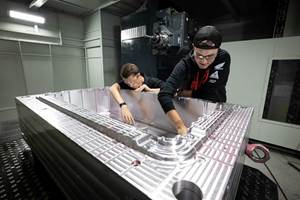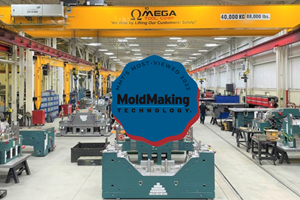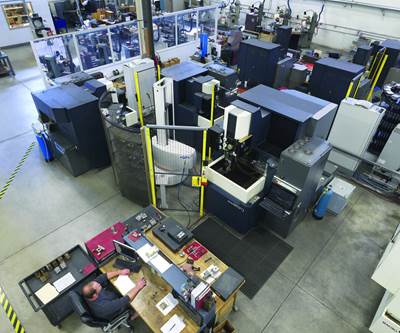Single CAD/CAM System Delivers a Complete Process
Tebis CAD/CAM is a single software system that delivers a complete process from design to finished product with automation, simulation and individual modules.
There's nothing ordinary about Integrity Tool & Mold (Integrity). From its founding in the Windsor suburb of Oldcastle in 2001, Integrity has been committed to lean design, advanced technology and continuous improvement, and it has paid off. By 2008, the young firm had built itself into a $60-million per year company. Today, that figure stands at around $150 million and the company has opened facilities in Pulaski, Tennessee, and Querétaro, Mexico. Yesterday's small Windsor-area shop now has 362 employees in Canada, over 600 employees globally and a total of 257,000 square feet. It has more than 100 spindles and produces about 400 plastic injection molds per year.
In recent years, Integrity's drive for continuous improvement and commitment to goals like quality and efficiency have been aided by Tebis software from Tebis America Inc. of Troy, Michigan. Tebis offers an integrated suite of CAD/CAM products. Apart from the power of the many individual modules, that each module uses the same database and user interface maximizes the speed and accuracy with which part data can be moved into production.
“In 2011, Integrity started to move to Tebis in a big way,” Vernon Benson, a Tebis account manager, says. Integrity had a strategic vision of having one main software product comprehensive enough to encompass its entire process, and from its research, the company determined that Tebis could be that software. The capabilities of the software’s individual modules were another benefit. Take simulation, for example. “It's vital that we thoroughly and realistically check our programs before we release them to the shop floor,” Integrity’s Director of Manufacturing Ryan Hotchkiss says. “Tebis allows us to do that and be very confident in implementing lights-out machining.”
Fully Integrated Simulation Optimizes Operations
That confidence comes from the multiple capabilities of the Tebis software module. It enables users to reproduce entire machining sequences and do so on virtual versions of the machines on their floor. The software helps users optimize machine operation functions like collision avoidance, tool-length checking and the ability to interactively define optimum tilt direction. In addition, the Tebis module's material removal simulation helps users assess the productivity and ultimate surface qualities of machining programs before any metal is cut.
This simulation is possible because Tebis personnel visit the customer to physically measure the exact machine parameters to encapsulate the entire machine environment, including the excess space required to make tool changes and the space between tool paths. This provides an exact 1:1 comparison between the real machine and the machine environment within the Tebis software, which is referred to as a virtual machine or a virtual machine build.
These tools are particularly useful for five-axis milling, which is increasingly important for Integrity as it looks to save time by capitalizing on using more axes. The use of more axes means more cuts taking place on one machine as opposed to using multiple machines for the same job. “Before they calculate an NC program, they can perform a detailed analysis of the tilt directions for the cutting tool, also taking head geometry and machine kinematics into account,” Tebis's Senior Manager Global Strategic Accounts John Kowalczyk says. Collision avoidance calculations include the holder components defined in the Tebis tool library. The Tebis simulator also checks all machine components and limit switches.
When operating in the virtual machine within Tebis, a customer assesses the part as well as the most effective machining strategy on that machine. The customer can then simulate this action and test its feasibility, making changes or corrections to improve the program. The benefits of this robust simulation capability are many and include unattended, lights-out machining, tool-damage avoidance, expensive post-collision machine repair prevention, and setup and run-time reduction. Additional downstream effects include improved accuracy, less rework and high-quality surface finishes.
The simulation also provides support for evaluating job costs. Tebis software estimates the time for each program, providing customers with important planning and scheduling information. Customers then have a plan of action before heading to the actual machine.
Kowalczyk notes that some of Integrity's competitors use simulation, but typically they use a third-party package, transferring data into and out of their CAD/CAM system. This slows
programming and increases the opportunities for error. This doesn't happen for Integrity, since simulation is fully integrated within the Tebis suite of software tools. This means that the Tebis virtual machine is accessible within the same software package as the rest of the Tebis CAD/CAM modules. Customers using the virtual machine environment would be in the same Tebis interface under the same computer window and would not need to share or exchange data between systems as a third-party software solution would require.
“The keywords are simplify and speed.”
Automation Standardizes Programs and Supports Speed
The process at Integrity goes above and beyond simulation. “The NC automation module in Tebis, with features like its template-style programming, has been very valuable,” Hotchkiss says.
The automation draws on the Tebis process libraries, which reflect the actual manufacturing environment. All tools, machines and clamping devices are stored in the library, along with geometric and technical properties. This benefits NC programmers as they select the appropriate machine in this virtual environment, define the optimal setup and select the appropriate tools, speeds and feeds.
“So, the program is partially written beforehand,” Benson says. “The programmers can then employ our feature-based, template-style approach, aided by robust algorithms within Tebis that speed preparation and programming, even for large components and complex geometries.” In addition, simultaneous calculation processes help accelerate NC programming, and the software's multiple setup and tool-match facilities can save significant time on the shop floor.
“The keywords are simplify and speed,” Hotchkiss says. This is a benefit for any shop but especially for one like Integrity, which has expanded so quickly that often it is difficult to find quality programmers. This is where Tebis software can play another vital role. Its template-based programming standardizes similar programs so that a new programmer can get set up and can start moving quickly.
Fast and simple are fine of course, but ultimately, it is the quality of the final product that matters. “Tebis shines here as well,” Hotchkiss says. “That's because it is a robust, surface-based machining software that does not depend on mesh models, which is especially valuable for Integrity since its products feature highly complex surfaces that require a high degree of accuracy.”
The big difference between a mesh-based and a surface-based approach is that the surface that mesh data creates is essentially like the pattern on the surface of a soccer ball (a series of pentagons). “As a result, you can’t generate highly accurate curves. In addition, mesh creates a surface that can be very ‘heavy.’ That is, the representation of the part’s surface is created using many smaller surfaces (or pentagons). This added ‘weight’ can be a problem when generating tool paths,” Benson says. A Tebis surface, by comparison, is ‘light,’ which makes it easier to work with, resulting in higher quality and more accurate surfaces, according to Benson.
Single Solution Streamlines Process
Along with simulation, Integrity has more than 80 Tebis seats and employs a broad array of Tebis modules, including mold and die, collision check, viewer NC, surface morphing, boundary representation (BREP), reverse engineering, electrode prep, various five-axis milling modules (3+2 machining and five-axis simultaneous) and more. But apart from the capabilities and success of individual modules and functionalities, Ryan Hotchkiss feels the biggest benefit of this collaboration is the ability to take the design from the CAD system right through to the finished product. It is Tebis’s single software system that helps deliver this complete process.
“There are numerous efficiency gains from the entire shop running from one software system,” Hotchkiss says. “It means having one file. Multiple file setups in different software takes time and invites errors. One file means less human interaction and less wasted time referring to multiple files and easier training.”
“There are numerous efficiency gains from the entire shop running from one software system.”
Related Content
Hybrid Milling/Drilling Machine Reduces Total Mold Machining Time
MSI Mold Builders now squares, plus drills and taps eye-bolt holes on 50% of its tools in a single setup using a five-axis milling/drilling center with a universal spindle.
Read MoreAdvances in P20 Steel Potentially Eliminates Need for Stress Relieving After Rough Cutting
Omega Tool Corp. compares conventional, new P20 grades side by side in production fascia tools, finds no downside.
Read MoreControl Helps Push the Limits of Five-Axis Micro Mold Machining Accuracy
Toolmaker quickly meets the demands of critical medical device manufacturers with a new five-axis machine tool equipped with the right control technology.
Read MoreCAM Automation Increases Mold Production, Quality
Mold builder switches CAM software package after 20 years to take advantage of innovative programming strategies that reduce mold machining programming and processing times.
Read MoreRead Next
Milling and EDM Automation Reshape Summit Tooling’s Mold Operations
Summit Tooling President Dan Martin credits the capability to run unattended machining 24/7 to the partnership that his company built with Makino.
Read MoreHow to Use Strategic Planning Tools, Data to Manage the Human Side of Business
Q&A with Marion Wells, MMT EAB member and founder of Human Asset Management.
Read MoreReasons to Use Fiber Lasers for Mold Cleaning
Fiber lasers offer a simplicity, speed, control and portability, minimizing mold cleaning risks.
Read More
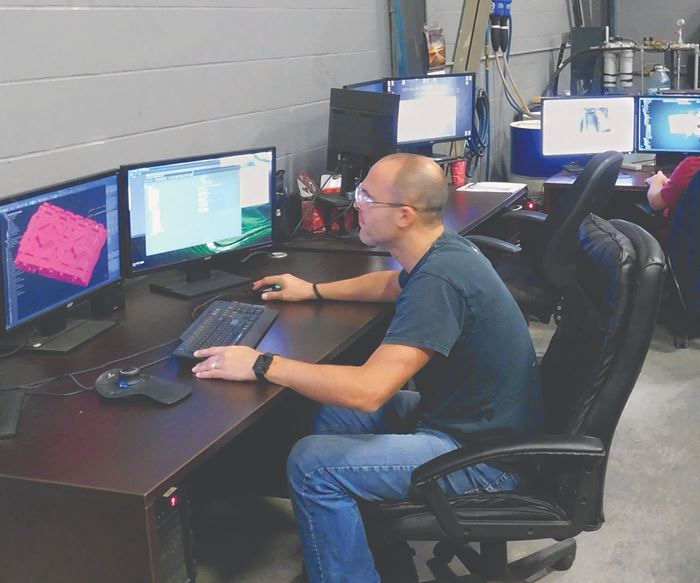

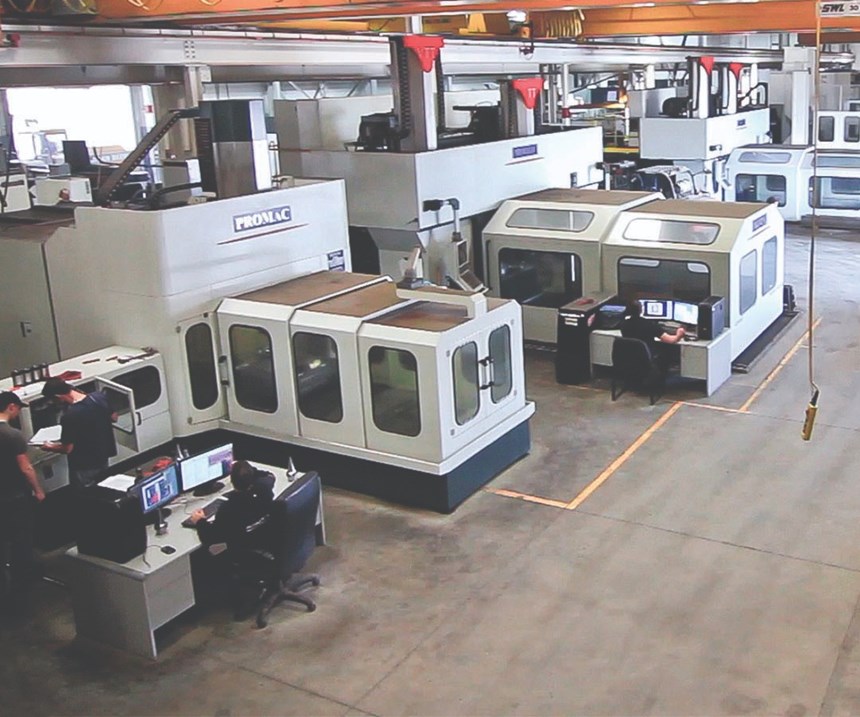
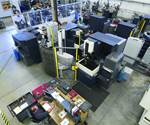













.jpg;maxWidth=300;quality=90)






